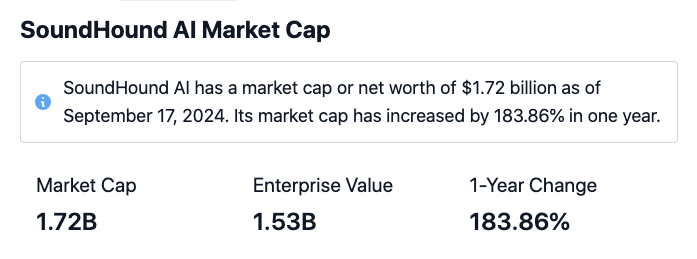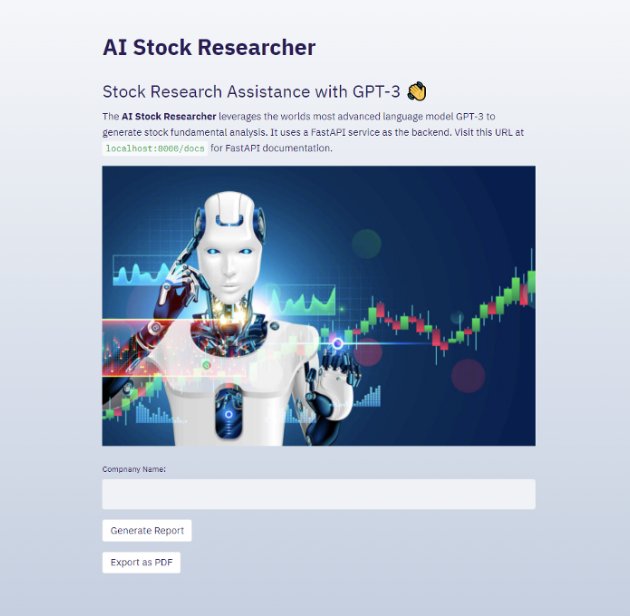20 Handy Facts For Choosing AI Stock Predicting Sites
20 Handy Facts For Choosing AI Stock Predicting Sites
Blog Article
Top 10 Tips To Assess The Accuracy And Performance Of Ai Platforms For Predicting And Analysing Stocks
To ensure that the tool you choose will provide accurate insights and forecasts, it is essential to evaluate its performance and accuracy. Here are the 10 best suggestions to help you analyze these platforms.
1. Backtesting Results
What to look for: See whether the platform allows backtesting to test how its predictions would've performed using previous data.
Why It's Important: Backtesting can help you determine the reliability of an AI model. This can be done by comparing the predicted outcomes to actual historic results.
TIP: Find platforms that allow you to alter the parameters used for backtesting (e.g., time periods and assets classes).
2. Real-time Performance Monitoring
What to look out for What happens to the platform during real-time conditions.
Why it Matters: The real-time performance of a platform is a more precise indicator than historical backtesting.
Tips: You can make use of an account demo, or an evaluation version of the program to monitor real-time movements and compare them to your predictions.
3. Prediction Error Metrics
What to Look For? Evaluate metrics such as mean absolute error as well as root-mean squared error Rsquared to measure accuracy of predictions.
What is the significance of these metrics are a quantitative way to determine how closely predictions match actual results.
Tip: Platforms which openly share their metrics tend to be more transparent and reliable.
4. Rate of Reward and Win Rate
What to look for: Check for the platform's winning rate (percentage basing its success on accurate predictions) and its success rate.
Why is it important: High success rates and win rates indicate better accuracy in predicting the future and a higher chances of earning.
It is important to be wary of platforms that make unrealistic claims (e.g., 90% %+),) in the sense that the system cannot guarantee its success.
5. Benchmarking using Market Indices
What to watch out for: Examine the performance and forecasts of the platform to the major market indexes.
What's important: This will help you find out if your platform has outperformed or falls short of the market overall.
Find out if you can achieve regular gains over a lengthy period of time.
6. The sameness across Market Conditions
What to be looking for What is the performance of the platform when there are various market conditions.
Why it is Important: The platform should be able to function in any market conditions, not only when the market conditions are favorable.
Tip Test the platform's forecasts in volatile times and during market declines.
7. Transparency in Methodology
What to Look For Learn about the AI models and algorithms employed (e.g. neural networks and reinforcement learning).
The reason it's important: Transparency allows you to assess the scientific and technical reliability of a system.
Avoid platforms that use models with "black boxes" without describing the process by which predictions are made.
8. User Reviews & Independent Testing
What to Look For: Read customer reviews and independent tests, or third-party evaluations.
Why it matters Reviews and testing conducted by independent experts give unbiased insight into the reliability and effectiveness of the platform.
Check out forums like Reddit or copyright to read what others have said.
9. Risk-Adjusted Returns
What to Look Out For The platform's performance can be measured with risk-adjusted metric such as Sharpe Ratio, or Sortino Ratio.
Why It Matters The metrics are used to measure the risk level taken to earn returns, giving an overall picture of performance.
Sharpe Ratio can be a useful indicator of the risk-adjusted return.
10. Long-term track records
What to look for Take a look at the performance of the platform over a long period (e.g. over three or five years).
What's the point. Long-term performance can be a better indicator for reliability than short term results.
TIP: Avoid platforms that focus on quick-term successes or results that are cherry-picked.
Bonus Tip: Test using an account that is a demo
Try a demo account or free trial to test the platform's predictions in real-time, without risking any real money. You can test the accuracy and performance of the system firsthand.
These tips will help you assess the reliability of AI stock-predicting and analysis platforms and choose one that matches your goals in trading and your tolerance for risk. Never forget that no platform is the perfect one. Combining AI insights with your own research is the most effective option. Have a look at the most popular stock analysis websites for blog examples including best stocks to invest in, best stocks to invest in, best ai copyright, ai stock trading app, ai copyright signals, stock predictor, best ai stock, ai trading app, chart ai trading, using ai to trade stocks and more.
Top 10 Tips For Assessing The Risk Management Aspect Of Ai Stock Prediction/Analyzing Platforms
Risk management plays a crucial part in any AI-based platform for trading stocks. It protects your capital by limiting the risk of losses and assists you in maximizing profits. Platforms with robust risk management capabilities can help you navigate market volatility and make an the right decision. Here are 10 tips on how to assess the capabilities of the platform's risk management tools.
1. Evaluating Stop-Loss or Take-Profit Features
Levels that can be customized - Make sure that the platform allows you to customize your stop-loss, take-profit and profit level for every strategy or trade.
Check if you can use trailing stops. They will automatically adjust if the market moves towards your advantage.
Check if your platform allows you to place stop-loss orders which guarantee closing your trade at the price you have specified, even in unstable markets.
2. Use Position Sizing Tools to Assess Positions
Fixed amount. Make sure you have the option to define your positions' sizes by a fixed dollar amount.
Percentage portfolio: Find out how risk can be controlled in a proportional way by setting your positions as a per percent of your portfolio's total.
Risk-reward rate: Check whether you are able to define the risk-reward percentages for specific trades or strategies.
3. Check for Diversification Support
Multi-asset trading: Make sure the platform permits you to trade across different types of assets, including ETFs, stocks, as well as options. This will allow you to diversify your portfolio.
Sector allocation: Check if the platform offers tools to monitor and manage sector exposure.
Geographic diversification: Verify if the platform supports trading in international markets to spread geographic risk.
4. Review leverage control and margins.
Margin requirements: Make sure the platform clearly outlines the margin requirements for leveraged trading.
Check for limits on leverage. This feature to limit your risk exposure.
Margin calls: Verify if the platform provides prompt notifications of margin calls to avoid account liquidation.
5. Assessment and Reporting of Risk
Risk metrics - Ensure that your platform has crucial risk metrics, such as the Sharpe ratio (or Value at Risk (VaR)) or drawdown (or value of portfolio).
Scenario Analysis: Find out the platform you use allows the ability to simulate various market scenarios in order to determine the potential risks.
Performance reports: Make sure the platform provides you with detailed reports on performance, as well as returns that are risk-adjusted.
6. Check for Real-Time Risk Monitoring
Monitoring your portfolio: Ensure that the platform allows you to track your portfolio in real-time.
Notifications and alerts. Check if the platform offers real-time notification of risk-related events.
Check the risk dashboards. If you wish to get a full picture of your risks, be sure that they're configurable.
7. Test Stress Testing and backtesting
Stress testing. Make sure your platform allows for you to stress test your portfolio or strategy in extreme market conditions.
Backtesting - See the platform you use allows you to backtest strategies with historical data. This is a great way to measure risk and assess the performance.
Monte Carlo simulations: Verify if the platform uses Monte Carlo simulations to model a range of possible outcomes and determine the risk.
8. Assess Compliance with Risk Management Regulations
Regulation compliance: Ensure that the platform is compliant with applicable risk management regulations (e.g., MiFID II in Europe, Reg T in the U.S.).
Best execution: Check if the platform adheres the best execution methods. This will ensure that trades are executed according to the best price available in order to reduce loss.
Transparency: Ensure that the platform has transparency and clear disclosures of risks.
9. Examine the parameters of risk that are user-controlled.
Custom risk rules for your business - Make sure the platform permits the user to set up your own risk management guidelines.
Automated Risk Controls: Check whether the platform has the capability to enforce risk management guidelines in accordance with predetermined parameters.
Check whether the platform permits manual overrides to automated risk control.
User feedback from reviewers and case studies
User reviews: Examine reviews from customers to evaluate the platform's effectiveness at risk management.
Case studies or testimonials should demonstrate the platform's ability to manage the risks.
Community forums: Find out if there's an active community of traders who share their tips and strategies to manage risk.
Bonus Tips:
Trial period for free: Test the risk management capabilities of the platform in real-world scenarios.
Customer support: Ensure you have a reliable support system regarding risk management related issues or questions.
Educational resources: Find out whether your platform provides instructional materials or tutorials that explain risk management practices.
Follow these tips to assess the risk management capabilities of AI trading platforms that can predict or analyze the prices of stocks. Choose a platform with an excellent level of risk management and you will reduce your losses. It is vital to have robust risk-management tools in order to successfully navigate the volatile markets. Check out the recommended ai stock trading hints for site examples including investing ai, artificial intelligence stocks, ai copyright trading bot, ai stock trading bot free, free ai trading bot, ai stock prediction, stock ai, ai stock trading, best ai trading app, best ai stocks and more.